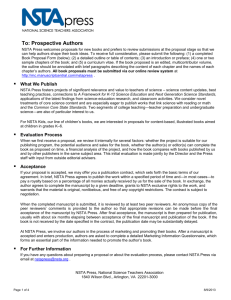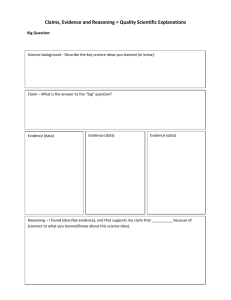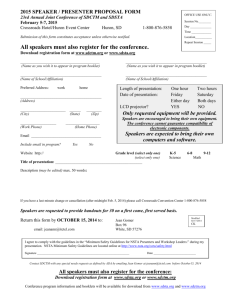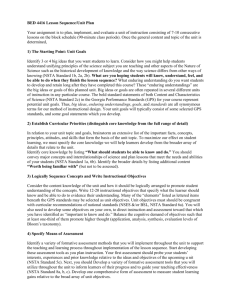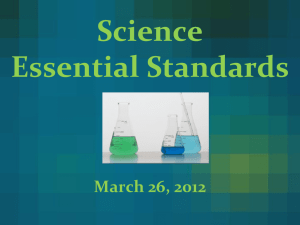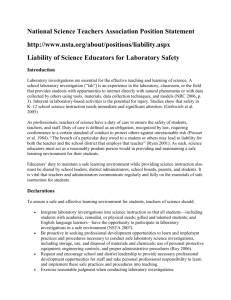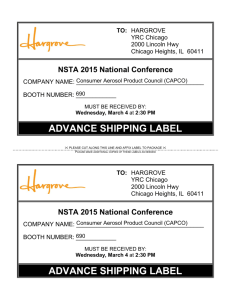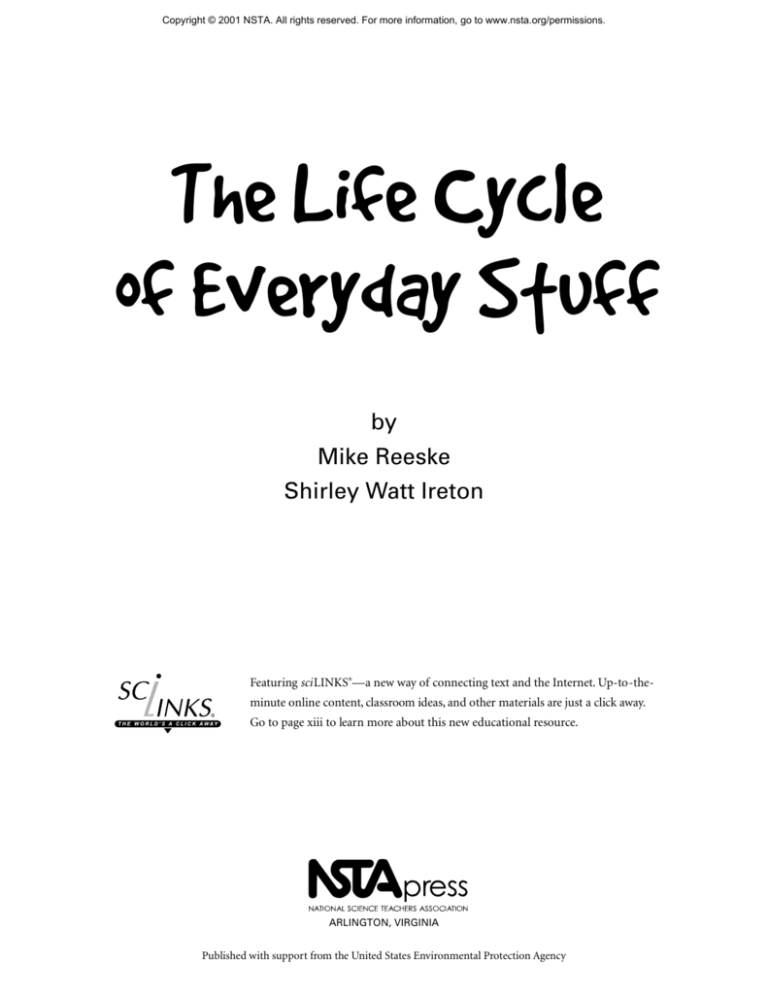
Copyright © 2001 NSTA. All rights reserved. For more information, go to www.nsta.org/permissions.
Chapter
The Life Cycle
of Everyday Stuff
by
Mike Reeske
Shirley Watt Ireton
Featuring sci LINKS®—a new way of connecting text and the Internet. Up-to-theminute online content, classroom ideas, and other materials are just a click away.
Go to page xiii to learn more about this new educational resource.
ARLINGTON, VIRGINIA
Published with support from the United States Environmental Protection Agency
Life Cycles of Everyday Stuff
i
Copyright © 2001 NSTA. All rights reserved. For more information, go to www.nsta.org/permissions.
Shirley Watt Ireton, Director
Beth Daniels, Managing Editor
Judy Cusick, Associate Editor
Jessica Green, Assistant Editor
Anne Early, Editorial Assistant
Art and Design
Linda Olliver, Director
NSTA Web
Tim Weber, Webmaster
Periodicals Publishing
Shelley Carey, Director
Printing and Production
Catherine Lorrain-Hale, Director
Publications Operations
Erin Miller, Manager
sciLINKS
Tyson Brown, Manager
National Science Teachers Association
Gerald F. Wheeler, Executive Director
David Beacom, Publisher
NSTA Press, NSTA Journals, and the NSTA
Web site deliver high-quality resources for
science educators.
Life Cycles
NSTA Stock Number: PB154X
ISBN 0-87355-187-7
Library of Congress Control Number: 00-110013
Printed in the USA by Automated Graphic Systems
Printed on recycled paper.
Copyright © 2001 by the National Science Teachers Association. All rights
reserved. The mission of the National Science Teachers Association is to
promote excellence and innovation in science teaching and learning for all.
Permission is granted in advance for reproduction for purpose of classroom or workshop instruction.
To request permission for other uses, send specific requests to:
NSTA Press
1840 Wilson Boulevard
Arlington, VA 22201-3000
http://www.nsta.org
Copyright © 2001 NSTA. All rights reserved. For more information, go to www.nsta.org/permissions.
Life Cycle Table of Contents
Introduction
Why Investigate the Life Cycle of Products? ........................................................ viii
What Is Life Cycle Assessment? ............................................................................... ix
How to Use This Book .............................................................................................. x
•
Instructional Design and Science Standards .................................................... x
•
Unit Overviews ................................................................................................. xi
•
Group Work .................................................................................................... xii
•
Using a Journal ................................................................................................ xii
•
Life Cycle of a Pencil poster insert ................................................................. xiii
•
Assessment ..................................................................................................... xiii
sciLINKS ................................................................................................................ xiii
About the Authors .................................................................................................. xiv
Acknowledgments .................................................................................................. xiv
Unit One: What Is a Life Cycle?
3
Summary ................................................................................................................... 1
Objectives .................................................................................................................. 1
Time Management .................................................................................................... 2
Materials .................................................................................................................... 2
Preparation ................................................................................................................ 2
Teaching Sequence .................................................................................................... 2
Learning Goals .......................................................................................................... 4
Resources ................................................................................................................... 5
Student Sheet 1.1
Introduction to Life Cycles—Matter and Energy Transformations ................ 7
Student Sheet 1.2
What’s in a Product and Where Does It Go? .................................................... 8
Unit Two: Dissecting a Telephone—Design
Summary ................................................................................................................... 9
Objectives .................................................................................................................. 9
Time Management .................................................................................................. 10
Materials .................................................................................................................. 10
Preparation .............................................................................................................. 11
Teaching Sequence .................................................................................................. 12
Learning Goals ........................................................................................................ 15
Resources ................................................................................................................. 16
Student Sheet 2.1
The Structure and Materials of a Telephone .................................................. 17
Student Sheet 2.2
The Functions and Design Rationale of Telephone Components ................. 18
Student Sheet 2.3
Life Cycle of a Product—Expert Roles ............................................................ 19
Life Cycle of Everyday Stuff
iii
Copyright © 2001 NSTA. All rights reserved. For more information, go to www.nsta.org/permissions.
Table of Contents
Unit Three: Raw Materials—
Acquisition and Processing
Summary ................................................................................................................. 21
Objectives ................................................................................................................ 21
Time Management .................................................................................................. 22
Materials .................................................................................................................. 22
Preparation .............................................................................................................. 22
Teaching Sequence .................................................................................................. 22
Answers to Student Sheets and Suggestions for Class Discussion ........................ 25
Learning Goals ........................................................................................................ 26
Resources ................................................................................................................. 27
Student Sheet 3.1
Raw Materials—Expert Roles ......................................................................... 29
Student Sheet 3.2
Processing Copper from Chalcopyrite Ore .................................................... 31
Student Sheet 3.3
Simulating Mining and Extraction of Copper from Ore ............................... 33
Unit Four: Manufacturing a Product
Summary ................................................................................................................. 35
Objectives ................................................................................................................ 35
Time Management .................................................................................................. 36
Materials .................................................................................................................. 36
Preparation .............................................................................................................. 36
Teaching Sequence .................................................................................................. 36
Learning Goals ........................................................................................................ 39
Resources ................................................................................................................. 40
Student Sheet 4.1
Test Sheet: Chill Out! ....................................................................................... 41
Student Sheet 4.2
Design Rationale Form .................................................................................... 43
Student Sheet 4.3
Post-Build Questions ....................................................................................... 44
Student Sheet 4.4
Manufacture of a Food Wrapper—Expert Roles ............................................ 45
3
Unit Five: The Useful Life of a Product
Summary ................................................................................................................. 47
Objectives ................................................................................................................ 47
Time Management .................................................................................................. 48
Materials .................................................................................................................. 48
Preparation .............................................................................................................. 48
Teaching Sequence .................................................................................................. 48
Answers to Student Sheets and Suggestions for Class Discussion ........................ 50
iv
National Science Teachers Association
Copyright © 2001 NSTA. All rights reserved. For more information, go to www.nsta.org/permissions.
Table of Contents
Learning Goals ........................................................................................................ 53
Resources ................................................................................................................. 54
Student Sheet 5.1
The Useful Lives of a Telephone and a Paper Cup—Expert Roles ................ 55
Student Sheet 5.2
Useful Lives Comparison ................................................................................. 57
Student Sheet 5.3
Lives of a Product ............................................................................................ 59
Student Sheet 5.4
Optional Research Activity—The Life of Your School’s Telephones .............. 60
Unit Six: A Tale of Two Cups—Disposal and Reuse
Summary ................................................................................................................. 61
Objectives ................................................................................................................ 61
Time Management .................................................................................................. 62
Materials .................................................................................................................. 62
Preparation .............................................................................................................. 62
Teaching Sequence .................................................................................................. 62
Answers to Student Sheets and Suggestions for Class Discussion ........................ 65
Learning Goals ........................................................................................................ 68
Resources ................................................................................................................. 69
Student Sheet 6.1
Disposal ............................................................................................................ 73
Student Sheet 6.2
A Tale of Two Cups .......................................................................................... 77
Student Sheet 6.3
Where Does a Telephone Go When It Dies? ................................................... 79
Unit Seven: Redesigning a Product
3
Summary ................................................................................................................. 81
Objectives ................................................................................................................ 81
Time Management .................................................................................................. 82
Materials .................................................................................................................. 82
Preparation .............................................................................................................. 82
Teaching Sequence .................................................................................................. 82
Answers to Student Sheets and Suggestions for Class Discussion ........................ 84
Learning Goals ........................................................................................................ 85
Student Sheet 7.1
A New Life for an Old Phone .......................................................................... 87
Student Sheet 7.2
Class Presentation Guide and Scoring Rubrics .............................................. 91
Appendix A
Reproduction of the Life Cycle of a Pencil Poster ................................................... 95
Life Cycle of Everyday Stuff
v
Copyright © 2001 NSTA. All rights reserved. For more information, go to www.nsta.org/permissions.
vi
National Science Teachers Association
Copyright © 2001 NSTA. All rights reserved. For more information, go to www.nsta.org/permissions.
Introduction
The Life Cycle
of Everyday Stuff
Life Cycle of Everyday Stuff
vii
Copyright © 2001 NSTA. All rights reserved. For more information, go to www.nsta.org/permissions.
Introduction
Why Investigate the Life Cycle of Products?
Sustainable
Development
In 1990, the World Commission
on Environment and
Development, a group developed
by the United Nations, defined
sustainable development as
“development that meets the
needs of the present without
compromising the ability of
future generations to meet their
needs.” Sustainable
development is a process that
balances both industrial and
economic growth. It takes a
broad systems view of what
sustains economies, the
environment, and human life.
It looks at ways to sustain the
quality of life for all people of the
Earth at a level that will allow a
balance between economic
health, environmental health,
and societal health. Life cycle
assessment uses the goals of
sustainable development and
applies them in a practical way
to the design, manufacturing,
use, and end-of-life options of
any product to make it more
“environmentally friendly“ and,
in the end, more sustainable
both now and in the future.
The National Science Teachers Association (NSTA), using a grant from the Environmental Protection Agency (EPA), designed these instructional units to help you and
your students explore a new tool—life cycle assessment. Parallel to living things,
material products also have a “birth, life, and death”—a life cycle. For a material
product, these steps include design, raw materials, manufacturing and distributing,
useful life, and disposal or reuse. Life cycle assessment is a relatively new tool for
science and economics. A life cycle assessment (LCA)—also called a cradle-to-grave
analysis—looks at the environmental impact of the total life of a product. Its goals are
to minimize the product’s negative or unplanned effects and maximize the product’s
usefulness and profit. With these goals, the design of the product ultimately affects
each stage of its life cycle. This book uses common products, such as the telephone,
to illustrate how LCA works.
Examination of the life cycle of a product also offers a systematic way to look at the
flow of energy and matter through the Earth’s system—a physical science parallel to
food webs. In the context of life cycles, these units use central science concepts to
explore the energy, raw materials, and waste issues that are part of the history of any
manufactured product. As students consider the trade-offs made at each life cycle step,
they will learn to recognize the decisions made by the producer to balance economic,
environmental, and developmental needs. In addition, they’ll have opportunities to
make parallel decisions about products they design and use.
These trade-off decisions are necessary in the goal of sustainable development.
What is sustainable development? According to the President’s Council on Sustainable
Development (1997): “A sustainable United States will have a growing economy
that provides equitable opportunities for satisfying livelihoods and a safe, healthy,
high quality of life for current and future generations. Our nation will protect its
environment, its natural resource base, and the functions and viability of natural
systems on which all life depends.” This goal of sustainable development calls upon
educators to expand American students’ conceptual awareness and take a systems
view of what we use, how we use it, and how it is disposed.
As this country becomes more technologically advanced, it is essential for students
to clearly see the important connections between a relatively small group of the
Earth’s raw materials and the products we value. For example, petroleum powers the
industries of our planet. However, few students understand that plastics are synthesized from refined petroleum. Nor do they understand that the energy to produce
nitrogen fertilizers is mostly generated from fossil fuels—a non-renewable resource.
Life cycle assessment gives students the opportunity to see these important
connections in natural and human-made systems. It allows them to make informed
decisions about the allocation of limited natural resources in the future, as these
resources diminish in size and their dollar costs escalate. These types of decisions,
based on the best science available, are the foundations of science literacy in our high
school curriculum. It is our hope that the use of these materials in your classroom will
contribute to the goals of science literacy for the 21st century.
Topic: sustainable development
Go to: www.scilinks.org
Code: LCS01
viii
National Science Teachers Association
Copyright © 2001 NSTA. All rights reserved. For more information, go to www.nsta.org/permissions.
Introduction
What Is Life Cycle Assessment?
Life cycle assessment originated in the early 1960s as workers tried to develop
materials and energy inventories to estimate the environmental impacts of product
manufacture. During the 1980s, Europe’s Green Movement reawakened interest in
LCAs. The Green Party called for a complete restructuring of social, cultural, and
political life, especially in the developed countries. Today, it looks at important issues
from the standpoint of the environment. The result—European manufacturers now
routinely take back and reuse or recycle products such as cars. According to the
Green Movement, examining life cycles is an important part of understanding the
relatedness of all issues.
Around the same time in the United States, several consulting firms conducted
landmark studies on solid waste. They analyzed the lives of common products such
as foam and paper cups, disposable and cloth diapers, and plastic and paper grocery
bags, using a cradle-to-grave analysis of energy and waste impacts at each stage of
the product’s life.
These studies included some surprising answers to hotly debated environmental
issues related to organic versus synthetic products. They found that plastic cups,
because they were uniformly made of a single material—polystyrene—are less
energy consuming and easier to recycle than the paper cup. They also produce less
total waste.
Life cycle assessment is now an important tool for technology and planning, as our
solid waste disposal options dwindle and energy prices continue to increase. LCA
is only one type of this increasingly popular method of sustainable design. Other
processes include eco-balance, resource analysis, and Environmental Impact
Assessment (EIA). However, LCA goes one step further and evaluates the inventory.
This step provides a quantitative catalog of the inputs (energy and raw materials) and
outputs (including environmental releases) for a specific product, process, or activity.
These are then used to evaluate such things as environmental effects, site selection for
manufacturing and distribution, habitat alteration, good management practices,
worker health concerns, community relations, and public perception. Once an
evaluation is complete, the company or agency rates the results and develops an
action plan to sustain economic growth while also sustaining the environment.
Why a Systems View?
Within a given system, the
components are related to each
other in defined ways. Until
recently, students examined
each separate component, but
rarely were given the opportunity
to look at the overarching
relationships between them.
Science teaching was based on
memorizing facts. In the early
1990s, an emerging consensus
among science educators
brought about the
implementation of more thematic
and integrated science programs.
These programs emphasized the
relationships between the major
scientific disciplines by using
such broad concepts as energy,
evolution, and systems and
interactions. In a parallel fashion,
the concept of sustainable human
development emerged.
Life Cycle of Everyday Stuff
ix
Copyright © 2001 NSTA. All rights reserved. For more information, go to www.nsta.org/permissions.
Introduction
How to Use This Book
The chapters in this book are organized around the stages in the life cycle of
a product:
Design
End-of-Life
and Disposal
Raw Materials
Acquisition
The Life Cycle
of a Product
3
Useful Life
Manufacturing,
Packaging, and
Distribution
Instructional Design and Science Standards
The authors assembled the units of The Life Cycle of Everyday Things using a “backwards” instructional design based on a process developed by Jay McTighe and Grant
Wiggins and published by the Association for Supervision and Curriculum Development as Understanding by Design. Using this method, the authors evaluated the levels
of knowledge that the units could address. In nearly any topic, in any area of study,
there is typically far more content than can or should reasonably be presented to
students. This design method provides a method to discriminate among three levels
of content: Enduring Understandings, Important to Know and Do, and Worth Being
Familiar With. These three levels established the curricular priorities—the Learning
Goals—on which to build the units.
The Enduring Understandings identified for each unit are core to the National Science
Education Standards and the Benchmarks for Science Literacy, and are required for
understanding of each stage of a product’s life cycle. These enduring understandings
are the ones that have value beyond the classroom, and that are transferable to new
situations.
As a second level of content, the authors identified the important knowledge (facts,
concepts, and principles) and skills (processes, strategies, and methods) that students
should master in order to understand the content of the unit. The Objectives for each
unit are derived from these first and second levels of content.
As a third level of content, the authors identified content that was just worth being
familiar with, perhaps that added perspective or detail. Content worth being familiar
with was built into the units in a broad-brush way: included as sidebars or extensions.
Once the authors identified the relevant content for each life cycle unit, the instructional methods for each unit were established. The authors built the instructional
delivery methods to account for a variety of learning styles. The constructivist
principles of identifying what students understand, and providing students with
opportunities to challenge and modify these preconceptions as they learn, were used
in each unit, and in the overall design of the book.
x
National Science Teachers Association
Copyright © 2001 NSTA. All rights reserved. For more information, go to www.nsta.org/permissions.
Introduction
The Learning Goals for each unit are at the end of the teacher sections, accompanied
by the relevant National Science Education Standards and Benchmarks for Science
Literacy. Most state or district science standards are correlated to these standards, and
you’ll find online correlations on several Web sites. These standards may guide your
selection of when to use The Life Cycle of Everyday Stuff with your classes, and provide
pointers toward using the concepts of life cycle assessments with other science
instruction.
Unit Overviews
The activities in this book are suitable for secondary Earth science, environmental
science, physical science, or integrated science classes. Unit Three may also be suitable
for chemistry classes.
Unit One: What Is a Life Cycle? introduces the concepts of a life cycle using the Life
Cycle of a Pencil poster. Through class discussion, the class extends the ideas of this
visual depiction to other common items and learns that all products have origins and
fates—a life cycle. They then focus on the matter and energy transformations at each
life cycle step—a process that develops student ability to see a product as part of a
cycle. Students will explore what they already know about product life cycles, and
complete a pretest of their current understanding that they will revisit and modify in
the final unit.
In Unit Two: Dissecting a Telephone—Design, students discover that a simple
product (e.g., a polystyrene cup) and a complicated product (e.g., a computer) each
must have a design that relates structure and function. This design is the result of the
synthesis of several perspectives: historical developments in the use of the product or
products with a similar function, energy expenditure, environmental impact, and
product economics. Students consider the structure and function of major telephone
components. They are then introduced to the roles they will use throughout the
remaining units to develop a way of understanding how the design process influences
every stage in the life cycle of a product.
Students next answer two questions about telephones and, indirectly, about all
products: What are they made of, and why? Unit Three: Raw Materials—Acquisition
and Processing examines the second stage in the life cycle—raw materials, and uses a
literature search to explore various aspects of three of the main materials in a
telephone: plastic, metals, and silicon chips. Through a laboratory experiment,
students model the extraction of metal from ore.
Unit Four: Manufacturing a Product discusses the step in the life cycle that creates
final products out of raw materials. Students make a protective package for a frozen
dessert and then consider materials and design options. They then weigh the energy,
economic, and environmental impacts of their package to highlight the trade-offs and
decision-making needed at each stage of the life cycle of a product.
Unit Five: The Useful Life of a Product explores the fourth stage in a product’s life
cycle. Students examine issues of durability, depreciation, and waste as they evaluate
this part of a product’s life cycle. The class will use mathematical and economic
concepts to illustrate the useful life of some common household products. As an
optional extension activity, students can conduct original research by following the
useful life of a school telephone.
What happens to a product when it no longer works and its useful life is over? The
last stage in a product’s life cycle is disposal or reuse—called the end-of-life stage. Unit
Six: A Tale of Two Cups—Disposal and Reuse has students examine the
trade-offs involved in selecting one drinking cup over another. They investigate what
Life Cycle of Everyday Stuff
xi
Copyright © 2001 NSTA. All rights reserved. For more information, go to www.nsta.org/permissions.
Introduction
would happen to each type of cup as a waste and review the concept of life cycles as a
way to consider waste management issues. Students then analyze the end-of-life stage
for a telephone. What happens to each component of a phone?
How can materials be redesigned to incorporate economic and environmental criteria
into their life cycle? In Unit Seven: Redesigning a Product, students examine the
strengths and weaknesses of the life cycle assessment tool to incorporate different
values in the design of a product. They use a telephone to examine the practice of
sustainable design and then develop their own criteria for evaluating a product. This
unit is an embedded assessment of student learning. Student teams present the results
of their research that began in Unit One. By analyzing how the design of the telephone
relates to each stage of its life cycle, students are able to synthesize the basic concepts
of this book.
Group Work
In The Life Cycle of Everyday Stuff, much of the student work will be done in teams.
Science is a cooperative endeavor, and teamwork allows students to engage in that mix
of individual thought and cooperative exchange that is real scientific investigation.
Also, the team approach offers an opportunity for students to explore viewpoints and
debate ideas. There are several non-contradictory ways to view each stage of a product
life cycle, and each viewpoint has a particular value at each stage. Units Two, Three,
Four, and Five have “Expert Roles” handouts for students. These handouts provide
questions to guide a member of each team to examine how History, Design, Energy
Flow, Environmental Impact, and Economics play a role at each stage of a manufactured product’s “life.” Student journals provide a record for answers, and team/class
discussions and team presentations provide the forum for exchange of practical ideas.
The teacher’s role during much of the group work will be as facilitator. You may wish
to circulate among the teams as they are working together, providing suggestions for
resources and perhaps changing the direction of a discussion.
Using a Journal
A lab journal will help students organize, analyze, and interpret the information they
collect throughout the course of their investigations. The journal will not only provide
students with a record of how their knowledge grows, but will provide you with a
mechanism for assessing student performance, understanding, and application of
knowledge. Journals enable students to organize information as they gather it, to share
it with peers, and to integrate class information toward successful participation in the
culminating activities. Writing also helps students develop ideas, think through
problems, make decisions, and determine what remains to be discovered.
Students can use a separate notebook or a section of a three-ring binder for their
journals. This allows for organization and for containment of single sheets that can be
easily turned in for grading. Organization is a critical learning skill for all students,
and journals must be organized to be useful and meaningful. You may want students
to number each page and construct a table of contents for their journals.
xii
National Science Teachers Association
Copyright © 2001 NSTA. All rights reserved. For more information, go to www.nsta.org/permissions.
Introduction
Assessment
The units have a mix of instructional techniques—class discussion, group discussion,
group and individual assignments, group and individual presentations, homework
questions, lab work, and independent research projects. Build rubrics to measure
what your students are learning based on your own instructional goals and on the
“Enduring Understandings” and “Important Facts and Skills” guides at the end of
each Teacher Section. Unit Seven, Redesigning a Product, concludes with group
presentations of their design work, and includes a multi-trait rubric to share with
students to guide their presentation development. You may wish to use Unit Seven
as a summative assessment of student learning in the previous units.
Assessments are the techniques to analyze student accomplishment against the
Enduring Understandings and Important Facts and Skills curricular priorities of the
unit. Many of the student tasks in The Life Cycle of Everyday Stuff serve as authentic
assessments—they are designed to have students simulate or replicate important realworld challenges. In Unit Four: Manufacturing a Product, for example, students
design, build, test, and redesign a simple product, gaining first-hand knowledge of the
challenges and illustrating their mastery of the process.
Journals are also important tools for assessment. Students should record all observations and activity results and include the separate student worksheets in their journals. In addition to answering specific questions, encourage students to record any
thoughts related to the issues covered in this book. You can use the journals to assess
students’ abilities to conduct the activities, their knowledge of the significance of the
activities, their understanding of the results and what they have learned, and their
abilities to use this information. Students will record their pretest of their life cycle
knowledge in their journals in Unit One. You may wish to encourage students to
revisit this pretest to have them concretely mark their gains of understanding
throughout the course of these units.
Life Cycle of a Pencil Poster Insert
Several units of The Life Cycle of Everyday Stuff suggest using the Life Cycle of a Pencil
poster, included with this book, as a visual reference of the parts of a life cycle. This
poster was initially designed for, and included with, Science Scope, NSTA’s journal for
middle level science teachers. Use it to broaden students’ awareness of product life
cycles. A small black and white version of the poster is included as an appendix.
sci LINKS
The Life Cycle of Everyday Stuff brings you sciLINKS, a creative project from NSTA
that blends the best of the two main educational “drivers”—textbooks and telecommunications—into a dynamic new educational tool for all children, their parents, and
their teachers. This sciLINKS effort links specific textbook and supplemental resource
locations with instructionally rich Internet resources. As you and your students use
sciLINKS, you will find rich new pathways for learners, new opportunities for
professional growth among teachers, and new modes of engagement for parents.
In this sciLINKed text, you will find an icon near several of the concepts you are
studying. Under it, you will find the sciLINKS URL (http://www.sciLINKS.org/) and
a code. Go to the sciLINKS Web site, sign in, type the code from your text, and you
will receive a list of URLs that are selected by science educators. Sites are chosen for
accurate and age-appropriate content and good pedagogy. The underlying database
changes constantly eliminate dead or revised sites or simply replace them with better
selections. The ink may dry on the page, but the science it describes will always be fresh.
Life Cycle of Everyday Stuff
xiii
Copyright © 2001 NSTA. All rights reserved. For more information, go to www.nsta.org/permissions.
Introduction
Acknowledgments
The site selection process involves four review stages:
NSTA, and authors Mike Reeske and Shirley
Watt Ireton, would like to thank the many
people who contributed to the development
of The Life Cycle of Everyday Stuff. First to
EPA’s Office of Solid Waste, whose funding
and vision made the project possible.
OSW staff Pat Washington, Judi Kane,
and Barbara Roth all worked to make this
project possible. Thank you next to the
advisory panel of Keith Wheeler, Judy
Baldridge, Nancy Ridenour, Kathleen Kaye,
and EPA’s Patty Whiting, who brought their
broad knowledge of science, science
education, and the environment to bear
in developing the plan for this book.
Christina Frasch Findlay brought talent
and enthusiasm to the coordination of the
development process.
1.
First, a cadre of undergraduate science education majors searches the World Wide
Web for interesting science resources. The undergraduates submit about 500 sites
a week for consideration.
2.
Next, packets of these Web pages are organized and sent to teacher-Web watchers
with expertise in given fields and grade levels. The teacher-Web watchers can also
submit Web pages they have found on their own. The teachers pick the jewels
from this selection and correlate them to the National Science Education
Standards. These pages are submitted to the sciLINKS database.
3.
Then scientists review these correlated sites for accuracy.
4.
Finally, NSTA staff approves the Web pages and edits the information provided
for accuracy and consistent style.
Thanks, then, to manuscript reviewers
Cathy Boucvalt of John Curtis Christian
School in River Ridge, Louisiana; Darrel
Boenig of Ben Franklin High School in
New Orleans, Louisiana; Susie Shields,
Environmental Education coordinator
for the Oklahoma Department of
Environmental Quality in Oklahoma City,
Oklahoma; Scott and Zelda Martin of
Putnam City High School in Oklahoma City,
Oklahoma; Judy Reeves of Baldwin County
High School in Bay Minette, Alabama;
and Debbie Dahl of Moore High School in
Moore, Oklahoma. Patricia Washington of
EPA provided research, resources, and
guidance, and coordinated the manuscript
review within EPA.
Tom Diener of Marshall School, Duluth,
Minnesota; Sue Ellen Lyons of Holy Cross
School, New Orleans, Louisiana; Jane
Brandt of Kellog Middle School, Rochester,
Minnesota; Tomas Rodriguez of Webb
Middle School, Austin, Texas; Marie Pool
of Clinton High School, Clinton, Oklahoma,
and their students provided invaluable
feedback as field testers of the manuscript.
Mike and Shirley both thank their families for
their support during the writing of this book.
Graves Fowler Associates provided the art
and layout; cover illustration is by Elizabeth
Brandt; inside illustrations by Joan Waites.
The Life Cycle of Everyday Stuff is
produced by NSTA Press: Shirley Watt
Ireton, director; Beth Daniels, managing
editor; Judy Cusick, associate editor;
Jessica Green, assistant editor. Anne Early
and Jessica Green were project editors
for The Life Cycle of Everyday Stuff.
xiv
National Science Teachers Association
Who pays for sciLINKS? sciLINKS is a free service for textbook and supplemental
resource users, but obviously, someone must pay for it. Participating publishers pay a
fee to NSTA for each book that contains sciLINKS. The program is also supported by
a grant from the National Aeronautics and Space Administration.
About the Authors
Mike Reeske has taught science in high schools for over 30 years and currently teaches
Chemistry and Integrated Science at Vista High School in Vista, California, where he
is the Science Department Chairman. He was the former Director of Education for
the Orange County Marine Institute and is currently a teacher-developer for the
Science Education for Public Understanding Program (SEPUP) at the Lawrence Hall
of Science, University of California at Berkeley. He has co-authored many SEPUP
modules and several books including Issues, Evidence and You and Science and
Sustainability, from which his current interest in life cycle assessment has come.
Shirley Watt Ireton is Director of the National Science Teachers Association Press and
NSTA’s Environment Education Coordinator. For the past 16 years she has developed
and managed science education projects with EPA, USGS, NASA, National Park
Service, USDA, Medtronic Corporation, Abbott Laboratories, and many others. The
results of these projects have been numerous award-winning publications for science
educators. Her interests are conveying leading-edge science to educators in classroomready ways, and modeling innovative teaching techniques in the development of
science education publications.
Copyright © 2001 NSTA. All rights reserved. For more information, go to www.nsta.org/permissions.
Unit 1
1
What Is a Life Cycle?
3
Summary
Just as living things go through a series of developmental stages
from birth to death, products must also complete a life cycle—from
design to disposal. However, the cycle does not stop with the end
of life. In nature, living things die and serve as energy for animals,
plants, and bacteria. Likewise, used products can be recycled into
new products, or simply discarded as waste. In both cases, matter
and energy are conserved.
Unit One introduces these concepts using the Life Cycle of a Pencil
poster. Through class discussion, you’ll extend the ideas on this
visual depiction to other common classroom items to emphasize
that all products have origins and fates—a life cycle. As a class, and
then as homework, students review and apply their knowledge of
the properties of matter and energy to the series of transformations
that make up the life cycle of a product.
Objectives
• To introduce the concepts
of life cycles
• To emphasize that all
products have a life cycle
• To apply knowledge of the
properties of matter and
energy to the series of
transformations that make
up the life cycle of a
product
Life Cycle of Everyday Stuff
1
Copyright © 2001 NSTA. All rights reserved. For more information, go to www.nsta.org/permissions.
Teacher Section
Preparation
Before class begins, place the objects on a table where students can clearly see them
as they enter the room. You may substitute other objects, but keep the telephone.
Display the Life Cycle of a Pencil poster. Duplicate enough copies of Student Sheet 1.1,
Introduction to Life Cycles—Matter and Energy Transformations, and Student
Sheet 1.2, What’s in a Product and Where Does It Go? You may need to do some
research in advance for the questions on Student Sheet 1.2, but this sheet is a starting
point record for students’ thinking about product life cycles.
Time Management
Two class periods
Materials
• A telephone that has ended its
useful life
• Pencils
• T-shirt
• Several objects commonly
discarded by most students
daily (e.g., milk cartons, soda
cans, a polystyrene foam cup,
a newspaper)
• Life Cycle of a Pencil poster
• A plant, preferably with flowers
or seeds
Teaching Sequence
Day One
Step One: Ask the class to analyze the objects on the table according to the following
three criteria: Where did the raw materials come from to make this object? How long
is the product useful? What happens to it when humans don’t find it useful any
longer? This should be a quick discussion, recording opinions on the board or on an
overhead. (Use the following table as a format, but the short discussion should focus
on the life cycle process, not on filling in the cells.)
Step Two: Use the Life Cycle of a Pencil poster as a guide. Hold up the pencil and have
students examine their own pencil. Ask students what they think the pencil is made of,
and fill in student answers in the Raw Materials column. The sidebar, “There’s No Lead
in Pencils!” provides some background for the discussion. Ask students where the
pencil’s raw materials come from, how the pencil arrived in the student’s possession,
and where the pencil will end up. Students should realize that some products have
many origins, and that even a simple product like a pencil can be the result of a
variety of natural resources and human labor from all over the world. Use the poster
to elicit and reinforce student contributions.
Students should realize that the time they spend interacting with an object is only a
portion of the “life span” of that object.
Product
Pencil
T-shirt
Soda can
Topic: life cycle of a pencil
Newspaper
Go to: www.scilinks.org
Telephone
Code: LCS02
Phone book
Disposable
diaper
2
National Science Teachers Association
Raw materials
Useful life
Then what?
Copyright © 2001 NSTA. All rights reserved. For more information, go to www.nsta.org/permissions.
Teacher Section
Step Three: When the level of discussion indicates that students are comfortable with
the idea of a pencil having a life cycle, draw attention to life cycles in nature. Ask
students for examples of life cycles in nature (humans, animals, plants). Record their
answers on the board or an overhead.
Use the plant to illustrate a parallel flow with raw materials (seed, water, root support);
manufacturing (sunlight, nutrients, water); useful life (continued growth, seed
production); end-of-life (death); and reuse (decomposition and return to nutrients
that may be used by other organisms). You may wish to sketch the cycle of the plant
to guide the discussion.
In an Earth science context, continue this parallel with the water cycle, nitrogen cycle,
or carbon cycle. In a biology or environmental science context, revisit what students
already know about composting, or more explicitly, food webs. Students should realize
that life cycles are pervasive in the world around them.
Step Four: Distribute Student Sheet 1.1, Introduction to Life Cycles—
Matter and Energy Transformations.
Introduce the Law of Conservation of Matter: In all physical and chemical
changes, matter is neither created nor destroyed, but it may be converted from one
form to another.
Relate this to the First Law of Thermodynamics—the Conservation of Energy: In all
physical and chemical changes, energy is neither created nor destroyed, but it may be
converted from one form to another.
Finally, further the idea of energy flow by introducing the Second Law of
Thermodynamics—when energy is changed from one form to another, some of the
useful energy is always degraded to lower-quality, more-dispersed, less-useful energy.
Students will revisit these concepts throughout The Life Cycle of Everyday Stuff as they
consider energy flow as part of each stage of the life cycle of an object.
Have students reproduce the Life Cycle of a Pencil in their lab journal. As directed in
Student Sheet 1.1, students write a sentence describing the changes in energy and
matter at each stage of the cycle.
Day Two
Step Five: As a class, review the homework. Assess student’s general understanding of
matter and energy transformations in their diagrams by checking to see if they have
shown the following at each stage: 1) energy inputs; 2) material inputs; 3) waste
outputs; and 4) waste energy as heat. Look for broad, general categories. Suggest to the
class that energy is lost at each stage. Where does this happen? Develop the idea of
heat loss and have them add arrows to their diagram to show this.
Step Six: Draw students’ attention again to the telephone. Hand out Student Sheet
1.2, What’s in a Product and Where Does It Go? Students should examine the
telephone in groups as they each fill out Student Sheet 1.2. Have them keep both
sheets in their lab journal.
These short questions are a pretest to the life cycle material and a guide for students
to apply the thinking they have just done on the life cycle of a pencil to the life
cycle of a telephone. Students should realize there are no right or wrong answers to
these questions.
There’s No Lead
in Pencils!
Contrary to popular belief,
pencils do not contain lead. Lead
was used in pencils throughout
the 19th century, but was
abandoned because it was too
soft and left only a light mark on
the writing surface. Lead is also
a toxic heavy metal that can be
hazardous to human health. In
1820, Joseph Dixon developed
a process of mixing clay with
graphite to make the writing
cores pencils still use today. The
graphite-clay mixture is blended
and extruded into pencil-sized
“leads.” The leads are baked at
982oC to make the material
smooth and hard.
The wooden part of a pencil is
made by cutting a block of cedar
wood into slats. The slats are
stained on one side and grooves
are cut into one surface. The
leads are placed into the grooves,
a second cedar slat is placed on
top, and the two slats are glued
together. This “pencil sandwich”
is milled to separate the
individual pencils. Each pencil is
painted and lettered. A metal
band called a ferrule is crimped
onto the end, and the eraser is
crimped into the ferrule to finish
the pencil. The eraser was once
made of rubber, but vinyl plastic
and synthetic rubber mixed with
pumice has replaced the rubber.
Use student answers to gauge where you need to place your emphasis in teaching
the rest of Life Cycle. Students should keep this sheet in their lab journal. After
completing Unit Seven, students can review their answers to Student Sheet 1.2 to
see what they have learned.
Life Cycle of Everyday Stuff
3
Copyright © 2001 NSTA. All rights reserved. For more information, go to www.nsta.org/permissions.
Teacher Section
Learning Goals
Unit One has been constructed to guide student understanding of the following
Learning Goals.
Enduring understandings
•
Life cycles are parallel in living and non-living things.
•
Matter has characteristic properties that are related to composition and structure.
•
In all physical and chemical changes, matter and energy are neither created nor
destroyed, but may be converted from one form to another.
•
When energy changes from one form to another, some of the useful energy is always
degraded to lower-quality, more-dispersed, less-useful energy.
•
Materials from human societies affect both the physical and chemical cycles of
the Earth.
Important facts and skills
•
Products can be categorized by their raw materials and by what happens to those
raw materials.
•
The five basic areas of life cycle assessment are: design; materials acquisition;
manufacture and transportation; use and maintenance; and recycling and
waste disposal.
•
Energy, human impact, and waste production are part of a complex system that
influences each step of the cycle.
These Unit One Learning Goals contribute to student learning of the following
National Science Education Standards and Benchmarks for Science Literacy.
National Science Education Standards
Unifying Concepts and Processes
Systems, order, and organization
Physical Science: Content Standard B
Structure and properties of matter
Conservation of energy
Interactions of energy and matter
Life Science: Content Standard C
Matter, energy, and organization in living things
Earth and Space Science: Content Standard D
Geochemical cycles
Science in Personal and Social Perspectives: Content Standard F
Natural resources
Environmental quality: Material from human societies affects both physical
and chemical cycles of the Earth
4
National Science Teachers Association
Copyright © 2001 NSTA. All rights reserved. For more information, go to www.nsta.org/permissions.
Teacher Section
Benchmarks for Science Literacy
4 The Physical Setting
4D Structure of matter
4E Energy transformations
5 The Living Environment
5E Flow of matter and energy
7 Human Society
7E Social trade-offs
8 The Designed World
8B Materials and manufacturing
8C Energy sources and use
11 Common Themes
11A Systems
Product Name Materials
Resources
Uses
Alternative Ultimate Fate
Uses After it is
no Longer Useful
LIFE CYCLES
Publications
Bower, M., and L. Warren. 1999. The Consumer’s Guide to Effective Environmental
Choices. New York: Union of Concerned Scientists.
Fava, J. A., Denison, R., Jones, B., Curran, M. A., Vogon, B., Selke, S., and Barnum, J.,
eds. 1991. A Technical Framework for Life-Cycle Assessment. Pensacola, Florida:
Society of Environmental Technology and Chemistry.
Hunt, R.G., and W.E. Franklin. 1996. LCA—how it came about: personal reflections on
the development of LCA in the USA. International Journal of Life Cycle
Assessment 1:4–7.
Hunt, R.G., Sellers, J., and W.E. Franklin. 1992. Resource and environmental profile
analysis: A life cycle assessment for products and procedures. Environmental
Impact Assessment Review 12:245–269.
U.S. Environmental Protection Agency. 1993. Life-Cycle Assessment: Inventory
Guidelines and Principles. Prepared for EPA by Battelle and Franklin
Associates, Ltd. Washington, DC. EPA/600/R-92/245.
Web Sites
Franklin Associates, Ltd., Life Cycle Assessment: http://www.fal.com/LCA/lca.html
The International Institute for Sustainable Development, Life Cycle Assessment
Technique: http://iisd.ca/business/lifecycle.htm
Society of Environmental Toxicology and Chemistry, Life Cycle Assessment:
http://www.setac.org/lca.html
Life Cycle of Everyday Stuff
5
Copyright © 2001 NSTA. All rights reserved. For more information, go to www.nsta.org/permissions.
Teacher Section
PENCILS
Web Sites
The General Pencil Company: http://www.generalpencil.com/
The Tennessee Pencil Company: http://www.tennesseepencil.com/
TELEPHONES
Publications
Meyer, R.O. 1995. Old-Time Telephones! Technology, Restoration and Repair. New York:
TAB Books.
Web Sites
Antique Telephone History: http://www.cybercomm.net/~chuck/phones.html
Invention & Design, Telephone Module: http://jefferson.village.virginia.edu/
~meg3c/id/id_telmod.html
Private Line’s Telephone History: http://www.privateline.com/TelephoneHistory/
History1.htm
Tribute to the Telephone: http://hyperarchive.lcs.mit.edu/telecom-archives/tribute/
Note: Web sites current as of August, 2000.
Videos
Biography: “Alexander Graham Bell: Voice of Invention” AAE-14146 (available through
http://store.biography.com/)
Biography: “Modern Marvels: The Telephone” AAE-12230 (available through
http://store.biography.com/)
PBS Home Video: “The American Experience: The Telephone” 2447-WEBHV
(available through PBS Home Video at http://shop.pbs.org/MDTQvsVN7s/
products/A2447/)
6
National Science Teachers Association
Copyright © 2001 NSTA. All rights reserved. For more information, go to www.nsta.org/permissions.
Student Sheet 1.1
Introduction to
Life CyclesMatter and Energy
Transformations
Law of Conservation of Matter
In all physical and chemical changes, matter is neither created nor destroyed, but it
may be converted from one form to another.
(It’s all still here.)
First Law of Thermodynamics
In all physical and chemical changes, energy is neither created nor destroyed, but it
may be converted from one form to another.
(You can’t get something for nothing.)
Second Law of Thermodynamics
When energy is changed from one form to another, some of the useful energy is
always degraded to lower-quality, more-dispersed, less-useful energy.
(You can’t break even.)
Directions
On a separate sheet of paper in your Lab Journal, draw a circle and fill in the stages
from the Life Cycle of a Pencil poster. At each stage of its life cycle the product is
changing. Its matter may be converted from one form to another, energy may be
added to the product, and energy may be released. Based on what you know of the life
cycle of a pencil, write a paragraph describing the changes in matter and energy at
each stage of its life cycle.
Life Cycle of Everyday Stuff
7
Copyright © 2001 NSTA. All rights reserved. For more information, go to www.nsta.org/permissions.
Student Sheet 1.2
What’s in a Product
and Where Does It Go?
The study you are about to begin will challenge you to examine the social and natural
resource issues related to the design and use of a common product—the telephone.
This is your initial look at the issues, a reference point for you to use to gauge your
own intellectual growth. These questions ask about your current knowledge of the
material in this unit. Record your answers in your lab journal.
Consider a telephone.
1.
List as many materials as you can think of that might be part of a telephone.
2.
For the materials you listed in Question 1, are there other materials that could
have been substituted for them 10 years ago? Fifty years ago? One hundred
years ago?
3.
Raw materials are either grown or taken from the Earth. For example, copper is a
raw material; wire is not. List as many of the raw materials as you can that might
have been used to make the materials you listed in Question 1.
4.
What energy may have been used to make these materials?
5.
Was energy used to get the telephone from its manufacturing point to where
it is now?
6.
How long does a telephone last before it is disposed of?
7.
What could happen to this telephone if it breaks?
8.
Does the telephone have pieces that could be recycled or reused?
9.
What pieces would produce the most waste if they were thrown away? How long
will it take to decompose?
10. Using the life cycle of a pencil as a model, sketch the components in the life cycle
of a telephone.
8
National Science Teachers Association

